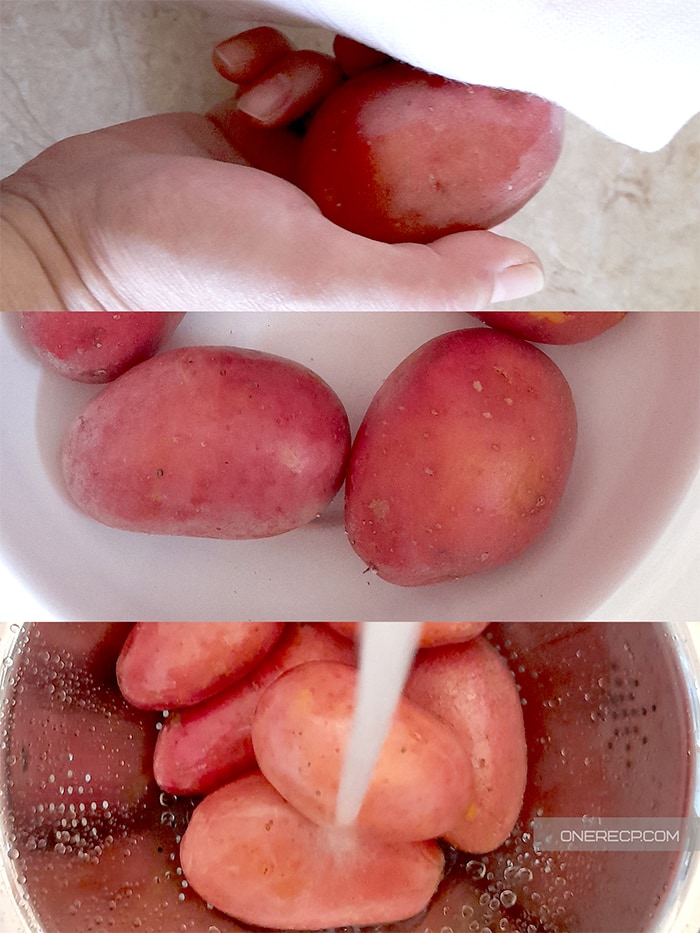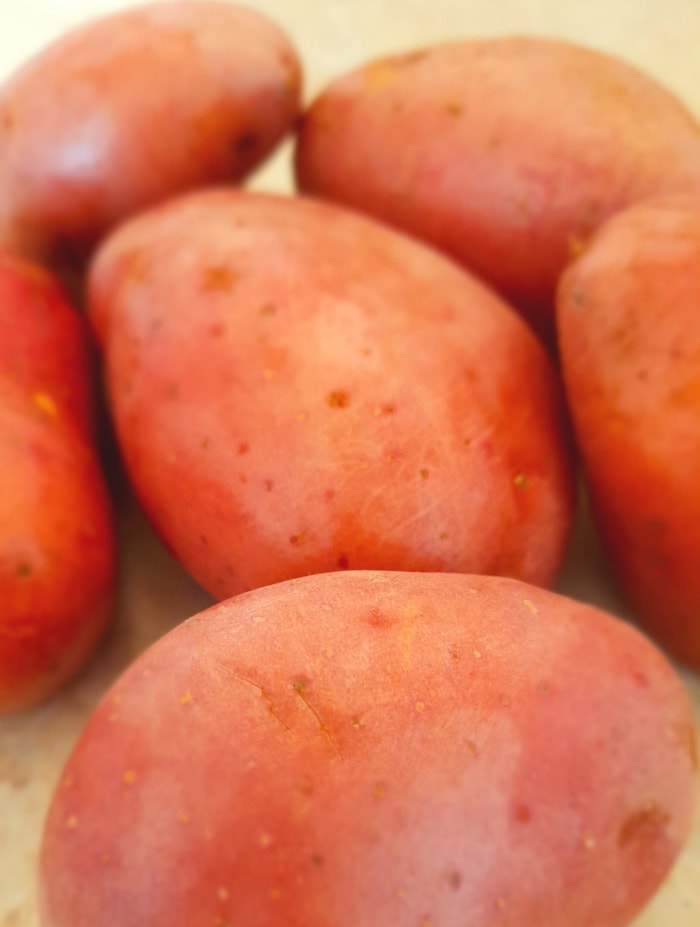Anyone who’s ever grown fruits and vegetables will attest that the potatoes sold at the supermarket look quite unnatural.
And that’s completely reasonable since some of the red potatoes sold at grocery stores are actually dyed red.
The first time I bought a bag of these potatoes I knew there was something odd about their perfect ruby color.
This awoke my inner critic so I did some research to find out why some of them were artificially colored.
Are red potatoes dyed?
Red potatoes are rarely used for anything other than roasting so their color seems almost alien in nature when we occasionally decide to put them in our shopping carts.
And it turns out that these concerns aren’t merely a product of our imagination.
There are over 200 hundred potato varieties that come in a wide range of colors due to a pigment called anthocyanins. Anthocyanins give some potato varieties a pronounced red or purple color. However, some farmers still use artificial dyes to paint their potatoes red or boost their color.
In fact, according to the USDA, artificial coloring is treated as a defect only when it’s used to conceal damage or it has penetrated more than 5% percent of a potato’s flesh. In these cases, the potato simply receives a lesser grade of approval.
If we dig a little deeper, we’ll find that potato dying isn’t a new practice. One of USDA’s compliance guides clearly states that growers began to use artificially colored waxes somewhere between 1940 and 1948.
This led to a number of complaints from dissatisfied customers who had bought red-dyed potatoes believing them to be a variety of sweet potatoes with red skins.
After examining these complaints, the USDA concluded that no action could be taken since the dyes weren’t poisonous, undeclared or used to conceal damage.
So, has anything changed since then?
Well, in brief, not all that much apart from a single piece of legislation stating that the term ‘yellow varieties of sweet potatoes’ shouldn’t include red-skinned potatoes.
Therefore, the only way to be sure if a red potato has been dyed or not is to get down and dirty and test it yourself.
How to tell whether a red potato has been dyed red?
Telling if a red potato has been sprayed can be a little bit tricky since there’s no available information about the dyes farmers use.
However, there are still a few methods you can use if you suspect your potatoes have an unnatural color.
Here’s how to find out if a red potato has been painted:
- Grab a potato and rub it in a wet towel. If the potato was sprayed, some of the dye will rub off.
- Rinse the potatoes in hot water. Red potatoes that have been artificially colored will lose their coloring once they get rinsed.
- Soak the potatoes in water. Place the red potatoes in a bowl and cover them with cold water. If they are painted, some of the dye will leech off in the water.

Bear in mind that boiling red potatoes will cause them to lose some of their color.
This shouldn’t concern you since the pigment responsible for their red color is water soluble.
However, unlike synthetic dyes, it doesn’t leech off into the water.
If you’re still worried that your red potatoes may be dyed, then you can simply opt for an organic alternative.
Are the naturally-red potatoes healthier than other potatoes?
Organic red potatoes are not only healthy but also a great source of potassium, vitamin B6, and niacin.
In fact, they contain more potassium than bananas.
This makes them a great post-workout meal that can restore your potassium levels back to normal.
When compared to regular potatoes, red potatoes contain mostly the same amount of nutrients with the exception of vitamin C.
Red potatoes contain half the vitamin C of their golden-brown counterparts.

However, they more than compensate for this with their ability to hold their shape during cooking.
As a result, they’re a better choice for potato salads and roasted potatoes.
But when it comes to dyed red potatoes things aren’t as clear-cut…
Since we don’t know exactly what kind of color additives have been used by the producers, there’s no way of predicting any possible health implications they might cause.
According to some studies, one of the most widely used commercial dyes, Red No. 40 can have adverse effects in some people. Red No. 40 is used to add color to fruits, jams, meat, poultry as well as a host of other food products.
In some rare cases, children suffering from ADHD can experience increased hyperactivity and irritability after consuming foods colored with Red No. 40.
Then again, there’s no sure way to tell whether red potatoes are really painted with Red No. 40 or some other dye.
The Bottom Line
Red potatoes are a naturally occurring potato variety that’s a common ingredient in many side dishes and garnishes.
Despite this, some farmers choose to use artificial dyes to make their red potatoes seem more appealing.
If you’re concerned about any potential side effects caused by these dyes, then it would be best to avoid red potatoes altogether.
You can do this by buying organic varieties that aren’t sprayed and don’t contain any GMO.
Read Next: Is It Safe To Eat Soft Potatoes?